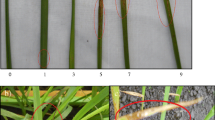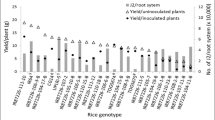Abstract
A total of 2256 germplasm accessions, 3000 advanced generation breeding lines and 150 released varieties of rice were screened under artificial infestation in the greenhouse. Among these, 15 new germplasm accessions, 50 breeding lines derived from 16 crosses and 15 released varieties were resistant. Antibiosis was the predominant resistance mechanism; antixenosis affecting oviposition was noted in 33 resistant varieties. Biochemical composition of a set of resistant varieties along with susceptible checks, revealed that nitrogen content of seven test varieties was significantly higher than that of the susceptible checks, while in other six varieties it was lower than the checks. Similarly, eight of the resistant varieties had considerably higher percentage of polyphenolic compounds in basal stem portion, but seven other cultivars showed significantly lower concentration as compared to susceptible checks. Thus, it was apparent that there was no clear trend among the resistant cultivars as a group in relation to quantitative differences of chemical components analysed.
Résumé
Un total de 2256 acquisitions de la banque de matériel (végétal) génétique, 3000 lignées avançées de selection de génération et 150 variétés de riz mises sur marché ont été soumises à l’infestation artificielle en serre pour criblage. Parmi celles-ci, 15 nouvelles acquisitions de la banque de matériel génétique, 15 lignées de selection issues de 16 croisements et 15 variétés mises sur marché ont été trouvées résistantes. Le méchanisme de résistance dominant ici était l’antibiose; l’antixénose liée à la ponte a été observée sur 33 variétés résistantes. La composition biochimique d’un lot de variétés résistantes aux côtés de témoins susceptibles a révélé que la teneur en azote de sept variétés testées était significativement plus élévée que celle de témoins susceptibles alors que chez six autres variétés, elle était plus faible par rapport aux témoins. De même, huit autres variétés résistantes avaient nettement un plus haut pourcentage de composés polyphénoliques au niveau de la base de la tige tandis que sept autres variétés ont montré une plus faible concentration, comparées aux témoins susceptibles. Par conséquent, il était évident qu’aucune tendance claire ne s’était dégagées au sein des variétés résistantes en tant que groupe vu les differences quantitatives au niveau de composantes chimiques analysés.
Similar content being viewed by others
References
Anonymous (1952) CRRI (Central Rice Research Institute) Annual Report, 1952. ICAR, New Delhi, India (Mimeo).
Anonymous (1969) AICRIP (All India Coordinated Rice Improvement Project) Progress Report, Kharif 1977. ICAR, New Delhi, India (Mimeo).
Anonymous (1970) AOAC (Association of Official Analytical Chemists) “Official Method of Analysis” 11th Ed. AOAC, Washington D.C.
Anonymous (1977) IRRI (International Rice Research Institute) Annual Report of 1976. Los Banos, Laguna, Philippines.
Anonymous (1981) Reaction of differential varieties to the rice gall midge Orseolia oryzae in Asia. International Rice Research Institute, Research Paper Series No.61, p. 14.
Anonymous (1983) All India Coordinated Rice Improvement Project (AICRIP). Progress Report, Kharif 1983—ICAR, New Delhi, India (Mimeo).
Anonymous (1984) Directorate of Rice Research (DRR), Progress Report Kharif 1984—ICAR, New Delhi, India (Mimeo).
Anonymous (1985) Directorate of Rice Research (DRR), Progress Report, Kharif 1985, ICAR—New Delhi, India (Mimeo).
Anonymous (1986) Directorate of Rice Research (DRR) Progress Report, Kharif 1986, ICAR—New Delhi, India (Mimeo).
Arifin K. and Van Vreden G. (1977) Mass rearing of the rice gall midge, Orseolia oryzae (Wood-Mason) Contrb. CRIA, Bogor, No. 12.
Das Y. T. (1976) Some factors of resistance to Chilo suppressalis in rice varieties. Entomol. exp. Appl. 20: 131–134.
Dubois M., Gilles K. A., Hamilton J. K., Rebers P. A. and Smith F. (1956) Colorimetric method for determination of sugars and related substances. Analytical Chemistry 28(3), 350–356.
Hegdekatti R. M. (1927) The rice gall midge in North Kanara. Agric. J. India 22: 461–463.
Heinrichs E. A. and Pathak P. K. (1981) Resistance to the rice gall midge, Orseolia oryzae in rice. Insect Sci. Applic. 1: 123–132.
Hidaka T. (1974) Recent studies on the rice gall midge, Orseolia oryzae (Wood-Mason), (Cecidomyiidae: Diptera). Rev. Plant Prot. Res. 7: 99–143.
Hidaka T. and Vungsilabutr P. (1971) Study on larval development of rice gall midge on susceptible and resistant rice varieties. Annual Report 1971. Rice Department. Ministry of Agriculture Bangkok, Thailand. 728 pp.
Israel P., Vedamurthy G. and Rao Y. S. (1961) Varietal resistance to the gall midge, Pachydiplosis oryzae (Wood-Mason) and other insect pests of paddy. Working paper No. 21. 9th meeting Working Party of Rice Production and Protection, FAO, International Rice Commission, New Delhi, India pp. 5. (Mimeo).
Joshi R. C. and Venugopal M. S. (1984) Mechanism of resistance in rice to gall midge Orseolia oryzae (Wood-Mason) I. Antibiosis. Indian J. Entomol. 46 (4), 479–481.
Kalode M. B. (1980) The rice gall midge—varietal resistance and chemical control. In Rice Improvement in China and other Asian Countries. IRR1 and Chinese Academy of Agriculture Sciences, IRRI, Los Banos Philippines, pp. 173–193.
Kalode M. B. and Bentur J. S. (1988) Donors for resistance to Andhra Pradesh biotype 4 gallmidge (GM). Int. Rice Res. Newsl. 13, 16.
Kalode M. B. and Bentur J. S.(1989) Characterization of Indian biotypes of the rice gall midge, Orseolia oryzae (Wood-Mason) (Diptera: Cecidomyiidae). Insect Sci. Applic. 10: 214–219.
Kalode M. B., Krishna T. S., Pophaly D. J. and Lakshminarayana A. (1977a) Note on new donors having multiple resistance to major insect pests of rice. Indian J. Agric. Sci. 47: 626–627.
Kalode M. B., Pophaly D. J., Kasi Viswanathan P. R. and Sreeramulu M. (1977b) Studies on resistance and mass rearing of rice gall midge Orseolia (Pachydiplosis) oryzae (Wood-Mason). Madras Agric. J. 64: 733–739.
Kalode M. B., Mangal Sain, Bentur J. S., Pophaly D. J. and Raghavaiah H. (1983) New donors and mechanism of resistance to gall midge in rice grown in the green house. Indian J. Agric. Sci. 53: 483–485.
Krishnamurthy Rao B. H. and Krishnamurthy C. (1964) Control of important sugarcane and paddy pests by cultural practices in Nizamabad district. Andhra Agric. J. 7(6), 218–228.
Modder W. W. D. and Alagoda A. (1971) A comparison of the susceptibility of rice varieties. IR 8 and Warangal 1263, to attack by the gall midge, Pachydiplosis oryzae (Wood-Mason) (Dipt., Cecidomyiidae). Bull. Entomol. Res. 61: 745–753.
Nguyen Cong-Tieu (1922) Note sur ure chcidomic du riz (Pachydiplosis oryzae) (Wood-Mason). Bull. Eco. Indo-China. 25: 590–592.
Panda N. (1979) Principles of Host Plant Resistance to Insect Pests. Hindustan Publishing Corporation, India (Delhi).
Pathak M. D. and Dale D. (1983) In biochemical basis of resistance in host plants to insect pests. In Chemistry and World Supplies. The New Frontiers, Chemerawen II (ed.) L. W. Schemilt. Pergamon Press, Oxford, New York.
Pathak M. D. and Khugh G. S. (1979) Studies on varietal resistance to brown plant hopper at IRRI. Paper Presented at Brown Planthopper Symposium. April 1977, IRRI, Philippines.
Pathak P. K. and Heinrichs E. A. (1982) A Bibliography of Varietal Resistance to the Rice Gall Midge, Orseolia oryzae (Wood-Mason). CAB, London.
Peraiah A. and Roy J. K. (1979) Studies on biochemical nature of gall midge resistance in rice. Oryza 16 (2): 149–150.
Perera N. and Fernando H. E. (1969) Laboratory culture of the rice gall midge, Pachydiplosis oryzae (Wood-Mason). Bull. Entomol. Res. 58, 439–454.
Prakasa Rao P. S. (1972) Ecology and control of Tryporyza incertulas (Walker) and Pachydiplosis oryzae (Wood-Mason) in rice. PhD. thesis, Utkal University, Bhubaneswar, India.
Rao Y. S., Israel P., Yadava C. P. and Roy J. K. (1971) Nature of gall midge resistance in rice. Curr. Sci. 40: 497–498.
Rajamani S. (1982) Factors affecting gall midge resistance in paddy. Ph.D.thesis, Utkal University, Bhubaneswar, India.
Roy J. K., Israel P. L. and Panwar M. S. (1969) Breeding for insect resistance in rice. Oryza 6(2), 38–44.
Roy J. K., Israel P. and Panwar M. S. (1971) Breeding for resistance to insect pests. Oryza 8 (Suppl.), 129–134.
Saxena R. C. and Khan Z.R. (1989) Factors affecting resistance of rice varieties to planthoppers and leafhoppers. Agric. Zool. Rev. 3: 97–132.
Seshu D. V., Prakasa Rao P. S., Kalode M. B., Shastry S. V. S., Srinivasan T. E., Rao J. R., Misra B. C., Prasad K., Rao U. P., Kulshreshtha J. P. and Roy J. K. (1974) Breeding for resistance to rice gall midge, leaf hoppers and planthoppers in India. In International Rice Research Conference, 1974. International Rice Research Institute, Los Banos, Philippines (Mimeo).
Shastry S. V. S., Freeman W. M., Seshu D. V., Israel P. and Roy J. K. (1972) Host plant resistance to rice gall midge. In Rice Breeding. IRRI, Los Banos, Philippines, pp. 353–365.
Sogawa K. (1973) Feeding behaviour of the brown plant hopper and brown planthopper resistance of indica rice Mudgo. Laboratory of Applied Entomology Faculty of Agriculture. Nagoya University. Bull. No. 4.
Swain T. and Hills W. E. (1959) The phenolic constituents of Prumus domestica. Quantitative analysis of phenolic constituents. J. Sc. Food and Agric. 10: 63–76.
Venkataswamy T. (1966) Association between hairiness and resistance to gall midge (Pachydiplosis oryzae) in rice. Andhra Agric. J. 13, 149.
Vidyachandra B., Roy J. K. and Bhaskar Das (1981) Chemical differences in rice varieties susceptible or resistant to gall midge and stem borer. Int. Rice Res. Newslett. 6(2), 7.
Author information
Authors and Affiliations
Rights and permissions
About this article
Cite this article
Sain, M., Kalode, M.B. Greenhouse Evaluation of Rice Cultivars for Resistance to Gall Midge, Orseolia Oryzae (Wood-Mason) and Studies on Mechanism of Resistance. Int J Trop Insect Sci 15, 67–74 (1994). https://doi.org/10.1017/S1742758400016787
Received:
Revised:
Published:
Issue Date:
DOI: https://doi.org/10.1017/S1742758400016787




